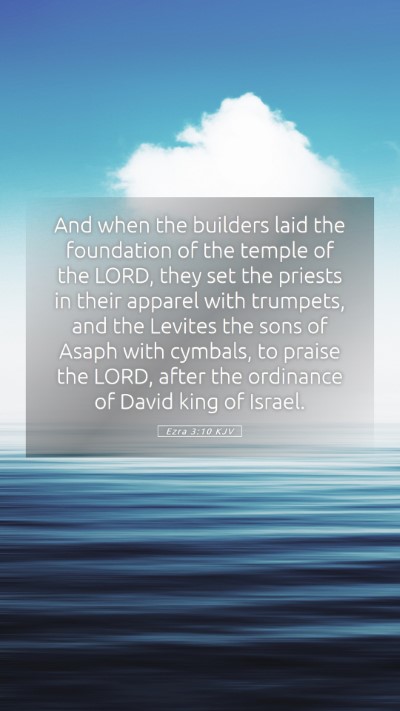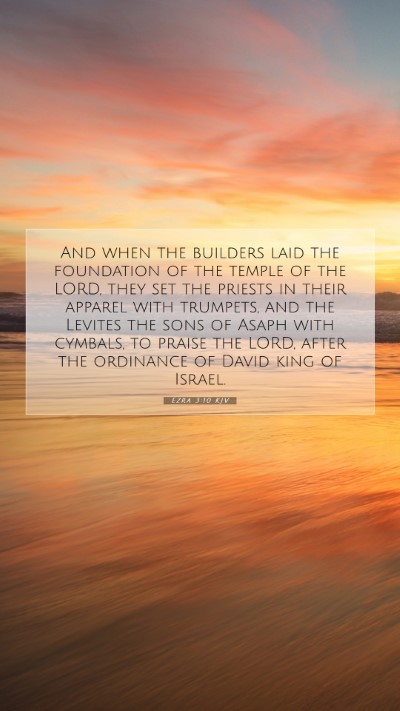Old Testament
Genesis Exodus Leviticus Numbers Deuteronomy Joshua Judges Ruth 1 Samuel 2 Samuel 1 Kings 2 Kings 1 Chronicles 2 Chronicles Ezra Nehemiah Esther Job Psalms Proverbs Ecclesiastes Song of Solomon Isaiah Jeremiah Lamentations Ezekiel Daniel Hosea Joel Amos Obadiah Jonah Micah Nahum Habakkuk Zephaniah Haggai Zechariah MalachiEzra 3:10 Meaning
What is the meaning of Ezra 3:10?
And when the builders laid the foundation of the temple of the LORD, they set the priests in their apparel with trumpets, and the Levites the sons of Asaph with cymbals, to praise the LORD, after the ordinance of David king of Israel.
Ezra 3:10 Bible Verse Meaning
Understanding Ezra 3:10
Ezra 3:10 reads: "And when the builders laid the foundation of the temple of the LORD, they set the priests in their apparel with trumpets, and the Levites, the sons of Asaph, with cymbals, to praise the LORD, after the ordinance of David king of Israel." In this verse, we observe the initial steps taken in the reconstruction of the temple following the Babylonian exile. The laying of the temple foundation is a pivotal moment for the returning exiles, marking their revival and dedication to worship.
Bible Verse Meanings
This passage emphasizes multiple aspects of worship and community in the context of biblical history. The act of laying the foundation symbolizes a new beginning for the people of Israel, a return to their religious practices and relationship with God. It represents their commitment to restoring their national identity and covenant with the Lord.
Historical Context
The return from Babylonian exile was monumental for the Jewish people, representing not merely physical liberation but spiritual restoration. Temple worship was central to Jewish identity, and Ezra's leadership played a crucial role in this restoration.
Insights from Commentaries
- Matthew Henry: Henry describes this event as a joyous and significant occasion, emphasizing the unity and collective effort of the community in rebuilding their temple. He notes that this act serves as a testimony to God’s faithfulness and the people’s desire to worship Him authentically.
- Albert Barnes: Barnes highlights the ceremonial aspect, stressing the importance of setting apart the priests and Levites for worship through music and praise. He posits that it is not merely the physical structure being rebuilt, but the spiritual essence and order of worship being restored as ordained by God.
- Adam Clarke: Clarke points out the significance of the musicians, stating that their praise is integral to worship. He reflects on the historical precedent set by King David, who established music in temple worship, thus denoting a continuity and adherence to God’s intentions in communal worship practices.
Key Themes
- Rebuilding and Restoration: This verse underlines the theme of rebuilding – physically, spiritually, and communally. It is a call to reestablish one’s faith and communal identity.
- Worship and Praise: The involvement of priests and Levites in musical praise signifies the importance of worship in the community’s life, showcasing that worship is both communal and celebratory.
- Leadership and Ordination: The mention of David’s ordinance reflects the importance of following divinely instituted models of worship, establishing that worship should adhere to God’s directives as laid out in Scripture.
Application to Daily Life
For contemporary believers, this passage can encourage the establishment of practices that foster a community of worship and collective identity. It serves as a reminder to prioritize worship in both communal and personal life, reinforcing the significance of tradition in faith.
Cross References
- 1 Chronicles 15:16: Discusses the appointment of musicians for worship.
- Nehemiah 12:27: Talks about the dedication of the wall of Jerusalem with great celebration.
- Psalms 150: A call to praise God with various instruments, reflecting the importance of music in worship.
Conclusion
Ezra 3:10 illustrates a profound moment of restoration amidst a backdrop of challenge and exile. Biblical exegesis allows us to derive true meaning from this verse when we appreciate its historical context, worship practices, and literary significance. Understanding such verses becomes essential for personal and communal faith journeys and enriches our Bible study insights.


